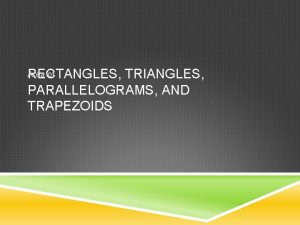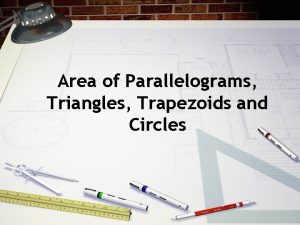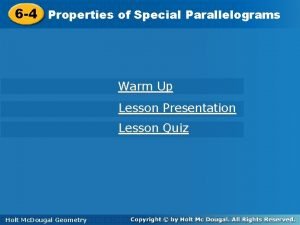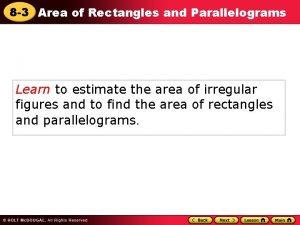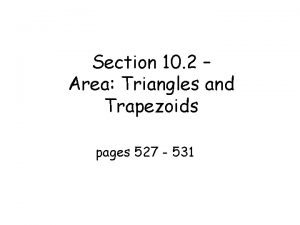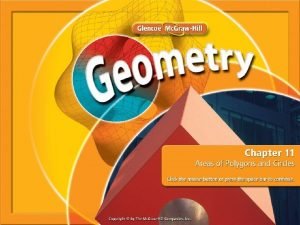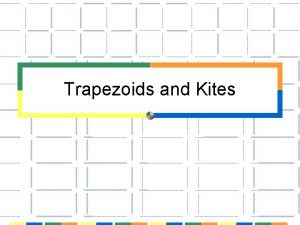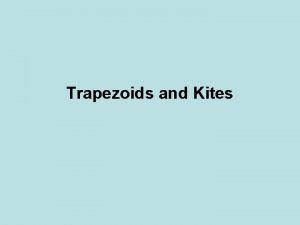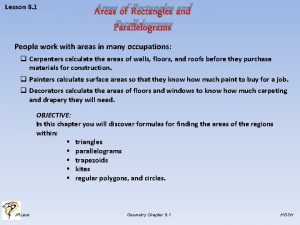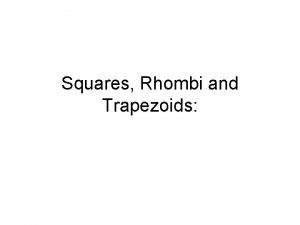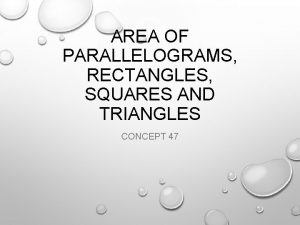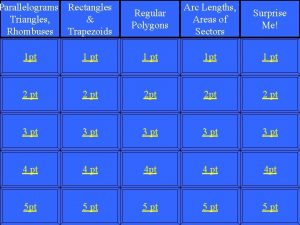Area of Rectangles Squares Parallelograms Triangles and Trapezoids








- Slides: 8

Area of Rectangles, Squares, Parallelograms, Triangles, and Trapezoids

Area of Rectangles Width 3 in. Length 9 in. The area of an object is how many squares it would take to cover the inside of an object. Area is always measured in square units. For a rectangle, this can be calculated by multiplying the length times the width.

Area of Squares Side 3 in. A square is a special type of rectangle. A square has all sides the same length. Side 3 in. Therefore, we do not need a length and a width. We can simply call them sides. The area of a square can be calculated by multiplying side by side…or side squared.

Area of Parallelograms 4 cm We know the area of a rectangle is length times width. 7 cm We can take the rectangle, cut off one side, and add it to the other side. The area must still be 4 times 7 or 28 cm. 2. Therefore, the area of parallelogram is same as a rectangle.

Area of Parallelograms 5 cm 4 cm 7 cm For a parallelogram, we use the terms base and height. Remember, the height is measured straight up and down (like the doctor measures your height!). Therefore, the height of this parallelogram is 4 cm. , not 5 cm. The area of a parallelogram can be found by multiplying the base times the height.

Area of Triangles 4 cm 7 cm Starting with our same parallelogram, we can cut it in half to form two triangles. Half the area ended up in each triangle. Notice that the base and the height of the new triangle are the same as in the parallelogram. The area of a triangle can be found by multiplying the base times the height and then dividing by two.

Area of Trapezoids 4 cm A trapezoid is very similar to a parallelogram as well. Notice that you can flip (or reflect) the left side and it now becomes a trapezoid with the same area as the parallelogram. 2 cm. 7 cm. 9 cm. 5 cm. The area of this trapezoid must still be 28 cm. 2. Notice that the bottom base is now 2 cm. shorter and the top base is now 2 cm. longer.

Area of Trapezoids 9 cm. The trapezoid formula is very similar to the parallelogram formula. 4 cm 5 cm. Since the two bases (the two parallel sides) are now different lengths we have to AVERAGE the two bases. We can then multiply by the height just like the parallelogram. The formula looks complicated, but if you understand what it means it is much easier.
 Area of triangles parallelograms and trapezoids
Area of triangles parallelograms and trapezoids Area of parallelograms triangles and trapezoids
Area of parallelograms triangles and trapezoids 6-4 properties of special parallelograms
6-4 properties of special parallelograms Area of rectangle and parallelogram
Area of rectangle and parallelogram Practice 10-2 area triangles and trapezoids
Practice 10-2 area triangles and trapezoids 11-3 areas of trapezoids answers
11-3 areas of trapezoids answers Parallelograms trapezoids and kites are both
Parallelograms trapezoids and kites are both Isosceles trapezoid
Isosceles trapezoid Lesson 8.1 areas of rectangles and parallelograms answers
Lesson 8.1 areas of rectangles and parallelograms answers
